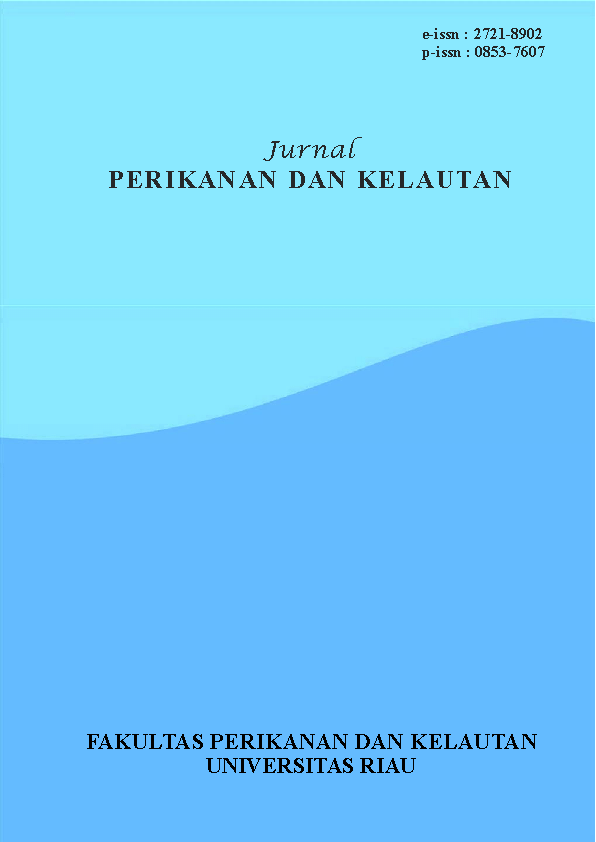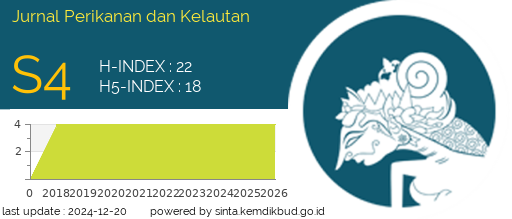Used of Thalassina anomala Protein Hydrolysate with Enzymatic Processes for Fortification in Instant Porridge
DOI:
https://doi.org/10.31258/jpk.29.3.381-389Keywords:
Thalassina anomala, Papain Enzyme, Protein HydrolysateAbstract
This research aims to discover the characteristics of Thalasina anomala protein hydrolysate fortification with instant porridge. The method used in this research is an experimental procedure with a completely random design. The research was conducted in 2 stages. Stage 1 is the production of shrimp protein hydrolysate with the enzymatic process, namely papain enzymes with concentration levels (10, 15, and 20%); the observed parameters are the chemical composition of meat, shrimp protein hydrolysis, and total amino acids. Protein hydrolysis results in stage 1 as a fortification raw material in stage 2, which produces instant powder with treatment (0%,5%, and 10%). The parameters tested include the chemical composition of shrimp protein hydrolysate fortifications with instant powder, water absorption, and powder solubility. The study results showed that the protein content of the shrimp meat is 84.98% (dw). The characteristic of the protein is produced using yellow-white papain enzymes with protein content of A1=77.44%, A2=80.56%, and A3=84.56% (dw). The degree of hydrolyze produced is A1 = 56.34 %, A2 = 64.51 %, and A3 = 69.19%. Shrimp protein hydrolysate contains amino acids with a total of 12.25%. Protein hydrolysis fortified with instant porridge produces organoleptic characteristics such as appearance B0=5.4, B1=5.3 B2=5,3, flavor B0 = 5.1, B1= 5.2 B2 = 5.0, Taste B0=4.8, B1=5,5 B2=5.8, and Textures B0=3.2, B1=3.6 B2=4.4. The chemical composition of shrimp protein hydrolysis fortified with instant porridge showed protein content is B0= 9.59%, B1= 18.56%, and B2= 22.54% (dw), with the absorption of water produced, is B0=4.68% B1=5.31% and B2=6.08%, and the solubility of the instant porridge produced B0=43.58%, B1=37.21% B2=33.46%.
Downloads
References
[SNI] Standar Nasional Indonesia. (2005). Syarat Mutu Kandungan Gizi MP-ASI. Badan Standarisasi Nasional. Jakarta.
Adebayo‐Oyetoro, A. O., Ogundipe, O. O., & Adeeko, K. N. (2016). Quality Assessment and Consumer Acceptability of Bread from Wheat and Fermented Banana Flour. Food Science & Nutrition, 4(3): 364-369.
Alsuhendra, A., & Ridawati, R. (2009). Pengaruh Modifikasi Secara Pregelatinisasi, Asam dan Enzimatis terhadap Sifat Fungsional Tepung Umbi Gembili (Dioscoreaesculenta). Jakarta. Universitas Negeri Jakarta.
Chanmugam, P., Boudreau, M., Boutte, T., Park, R. S., Hebert, J., Berrio, L., & Hwang, D. H. (1992). Incorporation of different types of n-3 fatty acids into tissue lipids of poultry. Poultry Science, 71(3),: 516-521.
Charoenphun, N., Cheirsilp, B., Sirinupong, N., & Youravong, W. (2013). Calcium-Binding Peptides Derived from Tilapia (Oreochromis niloticus) Protein Hydrolysate. European Food Research and Technology, 236: 57-63.
Dewita, D., Syahrul, S., Suparmi, S., & Lukman, S. (2017). Utilization of Fish Protein Concentrate from Patin Fish (Pangasius hypopthalmus) on Street Foods for Under Five Years Children at Kampar District, Riau Province. International J. of Oceans and Oceanography, 11 (1): 2017: 75-88.
Dompeipen, E.J., Kaimudin, M., & Dewa, R.P. (2016). Isolasi Kitin dan Kitosan dari Limbah Kulit Udang. Indonesian Journal of Industrial Research, 12(1): 32-39.
Edison, E., Dewita, D., Karnila, R., & Yoswaty, D. (2020). The Hydrolisis of Fish Protein From Giant Mudskipper (Periophthalmus schlosseri) Using Papain Enzyme. Journal Food and Nutrition, 8(3).
Farida, S.N, Ishartani, D., & Affandi, D.R. (2016). Kajian Sifat Fisik, Kimia dan Sensoris Bubur Bayi Instan Berbahan Dasar Tepung Tempe Koro Glinding (Phaseolus lunatus), Tepung Beras Merah (Oryza nivara) dan Tepung Labu Kuning (Cucurbita moschata). Jurnal Teknosains Pangan,1(1).
Ghazali, T.M., Sitinjak, F.R., & Simanullang, W. (2020). Description and Composition Chemistry of Meat and Carapace (Thalasina Anomala). Jurnal Perikanan dan Kelautan, 25(2): 138-144.
Girgih A.T., He, R., Malomo, S., Offengenden M., Wu J., & Aluko R.E. (2016). Structural and Functional Characterization of Hemp Seed (Cannabis sativa L.) Protein-Derived Antioxidant and Antihypertensive Peptides. J. Funct. Foods, 6:384–394.
Handayani, N.A., Santosa, H., & Kusumayanti, H. (2014). Fortifikasi Inorganik Zink pada Tepung Ubi Jalar Ungu sebagai Bahan Baku Bubur Bayi Instan. Reaktor, 15(2): 111-116.
Liceaga‐Gesualdo, A. M., & Li‐Chan, E.C.Y. (1999). Functional Properties of Fish Protein Hydrolysate from Herring (Clupea harengus). Journal of Food Science, 64(6): 1000-1004.
Lumentut, G. (2018). Formulasi Bubur Bayi Instam dari Tepung Pregelatinisasi Umbi Uwi Ungu (Dioscorea alata L.) dengan Tepung Kedelai (Glycine max L. Merr) sebagai Alternatif Makanan Pendamping Air Susu Ibu. Ilmu dan Teknologi Pangan. Universitas Hasanudin Makassar. Makasar.
Mahmud, M. K.M.S., & Hermana. (1987). Kadar Asam Lemak Omega-3 dalam Ikan di Indonesia. Makalah pada Seminar Manfaat Ikan Bagi Pembangunan Sumberdaya Manusia. Departemen Kesehatan dan Kantor Menteri Negara KLH. Jakarta.
Nilsang, S., Lertsiri, S., Suphantharika, M., & Assavanig A. (2005). Optimization of Enzymatic Hydrolysis of Fish Soluble Concentrate By Commercial Protease. Journal of Food Engineering, 70(1): 571-578.
Nurhayati, T., Nurjanah, N., & Sanapi, C.H. (2013). Karakteristik Hidrolisat Protein Ikan Lele Dumbo (Clarias gariepinus). Jurnal Pengolahan Hasil Perikanan Indonesia, 16(3).
Prastari, C,, Yasni, S., & Nurilmala, M. (2017). Karakteristik Protein Ikan Gabus yang Berpotensi sebagai Antihiperglikemik. Jurnal Pengolahan Hasil Perikanan Indonesia, 20(2).
Rusmaniar, R., Muhammad, A., & Windarti, W. (2014). Karakteristik Bioturbasi oleh Rama-rama (Thalassina Spp.) di Lingkungan Pesisir Bukit Batu, Bengkalis, Riau. Universitas Riau
Rutherfurd, S.M. (2010). Methodology for Determining Degree of Hydrolysis Protein Hydrolysates: a review. J AOAC Int, 93(5):1515-1522.
Suparmi, S., & Dahlia, D. (2020). Studi Fortifikasi Hidrolisat Protein Udang Rebon (Mysis relicta) pada Mie Sagu. Jurnal Agroindustri Halal, 6(1): 39–48.
Syamaladevi, R.M., Tang, J., Villa‐Rojas, R., Sablani, S., Carter, B., & Campbell, G. (2016). Influence of Water Activity on the Thermal Resistance of Microorganisms in Low‐Moisture Foods: A Review. Comprehensive Reviews in Food Science and Food Safety, 15(2): 353-370.
Tien-Chen, T. (2016). Computer Self-Efficacy and Factors Influencing E-Learning Effectiveness. European Journal of Training and Development, 36 (7): 670- 686.
Wijayanti, I., Romadhon, and Rianingsih, L. (2015) Characteristics of Milkfish (Chanos chanos Forsk) Protein Hydrolysate as effect of Different Bromelin Enzyme Concentration. Indonesian Journal of Fisheries Science and Technology 11 (2): 129–133.
Wijayanti, I., Romadhon, R., & Rianingsih, L. (2016). Karkateristik Hidrolisat Protein Ikan Bandeng (Chanos chanos F) dengan Konsentrasi Enzim Bromelin yang Berbeda. J. Saintek Perikanan, 11(2)
Winarno, F.G. (2002). Kimia Pangan dan Gizi. Gramedia Pustaka Utama. Jakarta.
Yanar, Y., Gocer, M., & Kucukgulmez, A. (2011). Differences in Nutritional Composition Between Cultured and Wild Green Tiger Shrimp (Penaeus semisulcatus). Journal Food, (436-440).
Zou T.-B., He T.-P., Li H.-B., Tang H.-W.,& Xia E.-Q. (2016). The Structure-Activity Relationship of the Antioxidant Peptides from Natural Proteins. Molecules. 21:72.








